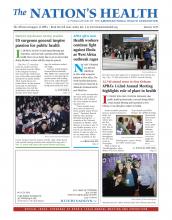Breast cancer is one of the most common types of cancer found in women. Your risk may vary depending on age, family history, lifestyle behaviors and more.
With so many things that factor into your risk, it’s important to catch any warning signs early with screenings such as a mammogram.

Photo by Monkeybusinessimages, courtesy of iStockphoto
A mammogram is an X-ray of the breast, says Jacqueline Miller, MD, FACS, medical director for the Centers for Disease Control and Prevention’s National Breast and Cervical Cancer Early Detection Program. The X-ray emits radiation and shows images of anything that is a hard structure inside the breast that may warrant a second look.
“Things that are not so hard structured, like fat, create a darker image,” Miller says. “That way, you can actually take a picture of the internal structures of the breast to see if there are any abnormalities or masses.”
By age 50, women should get regular mammograms every two years, according to the United States Preventive Services Task Force. A woman between the ages of 40 and 49 should talk with her physician about factors that may require her to get mammograms earlier, such as a family history of breast cancer, Miller says. Other risk factors include taking hormone replacement therapy, beginning your menstrual cycle early or starting menopause later in life, she says.
“If someone has lumpy breasts, new lumps in the breast, unexplained pain in the breast, or something unusual going on, that person may also need to have mammograms at an earlier age,” Miller says.
Don’t fall for mistruths
One of the biggest misbeliefs that prevent women from getting mammograms is that if no one in their families has had breast cancer before, they’re not at risk. But that’s a myth, Miller says.
“Seventy-five percent of women who develop breast cancers don’t have these risks that we know are associated with breast cancer,” she says. “They don’t have a family history. They are in good shape. They do exercise. You always wonder, well, why? Some of them can have genetic mutations. It may be multiple reasons.”
Some women also believe that getting a mammogram can cause cancer because of the radiation exposure from the X-ray, Miller says. However, the amount of radiation from a mammogram is “extremely small” and not enough to warrant concern of causing cancer, she says.
Pay no mind to the myths. By avoiding getting a regular mammogram, you can potentially delay a breast cancer diagnosis, resulting in a disease that may be more difficult to treat and affect your chance of survival.
“Mammograms can actually pick up on some breast cancers six months to two years before the cancer can be something that you actually feel with your hand,” Miller says.
Be aware of what to expect
Before scheduling your mammogram, there are some tips you should follow to have a successful appointment. Instead of a dress, make sure to wear a top with pants or a skirt as you’ll only need to remove clothes above the waist, Miller says.
Avoid wearing lotion or deodorant that day because particles may show up in the mammogram, she says. If you still get your period, CDC recommends that you avoid scheduling your mammogram either during your cycle or the week before because that’s when your breasts may be swollen or tender.
During the exam, you may be asked to place your breast on a plate while a second plate from above squeezes the breast in place to take an X-ray photo, Miller says. The same is also done from the sides of your breast. The same two X-rays are done for the second breast, she says.
“They do squeeze tight, but that tightness is very short — a few seconds — very short-lived in that timeframe,” Miller says.
While there may be some discomfort, it’s a worthy trade-off for a screening that may save your life.
Know your mammogram options
There are different types of mammograms women can receive, Miller says.
Digital mammography may provide a health professional the chance to see through denser breasts, she says. Women may also have access to 3-D mammography, where several images are taken to see through the breast.
People who are at high risk for cancer may need a magnetic resonance imaging scan in addition to a mammogram. An MRI may show more detail and is recommended for women who are at high, not average, risk for breast cancer, she says.
Talk to your doctor about which type of mammogram is the right one for you.
For more tips, visit www.cdc.gov/cancer/breast/basic_info/mammograms.htm
- Copyright The Nation’s Health, American Public Health Association












